Mario Sanchez: The Pride of Key West
Intro
This article first appeared in the spring 2014 issue of the Newsletter of the Print, Drawing & Photograph Society of the Baltimore Museum of Art. It describes my adventures in Key West last October in pursuit of the locally celebrated artist Mario Sanchez during intervals when I was not doing what I set out to do in accepting an artist residency at the Studios of Key West, namely enlisting local folks to model for my series of watercolors Up In Arms. To see those results, please go to http://www.scottponemone.com/gallery/up-in-arms/
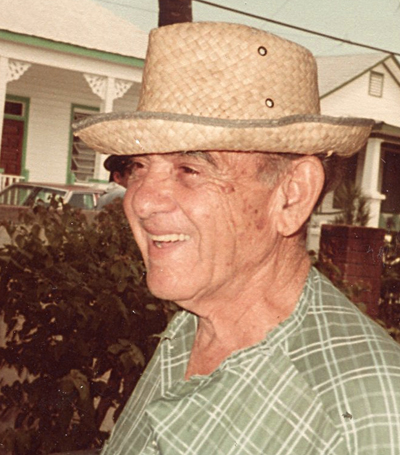
Mario’s Sphere of Influence
Whenever I travel, I’m on the lookout for indigenous printmaking and a possible print purchase. Last October in Key West no locally-made prints were to be found, but I did stumble upon the world of Mario Sanchez (1908-2005): his artwork and some of the people who contribute to his legacy. These include a gallery director, a museum curator, a volunteer catalogue raisonné compiler, a philanthropist and two nieces.
At first glance Sanchez’s finished polychrome low-relief carvings on exhibit at the Custom House (principal venue of the Key West Art & Historical Society) seemed too cute: one man’s folksy remembrance of Key West street scenes and the characters that animated them. They were soooooo charming. Here’s an example:
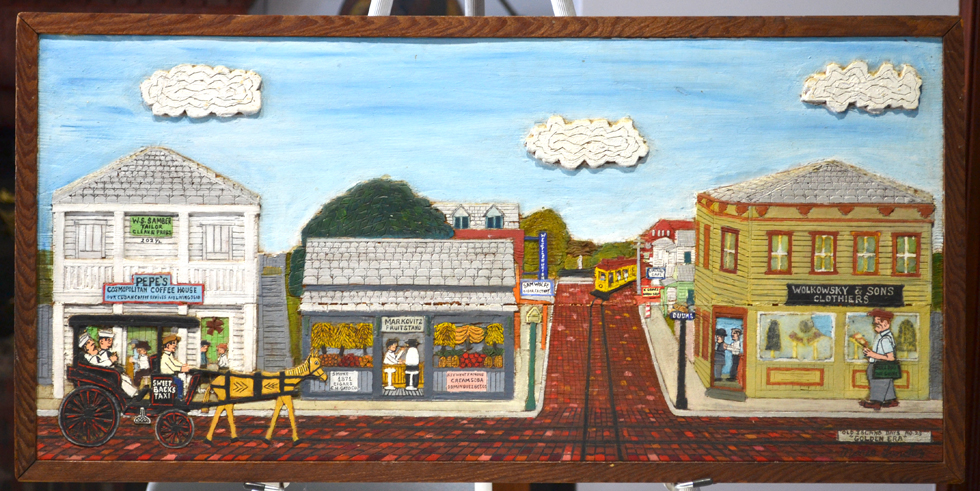
Mario Sanchez (American, 1908-2005) Old Island Days #23, Golden Era, wood & oil paint 16.5” x 33.25” x 1.1”, 1975 On permanent loan to KWAHS from David Wolkowsky (PHOTO BY SCOTT PONEMONE. Courtesy of Gallery on Greene, Key West)
But then at a private gallery I came across one of his drawings done on flattened brown paper grocery bags. For me it had two plusses going for it: 1) it was on paper and 2) it seemed much more lively—the artist’s hand and intention were visible. See a closeup of a drawing below. Note how both figures involved reworking, i.e. they were largely drawn on paper pasted onto the larger sheet. And both figures were first drawn in pencil, then overdrawn in ballpoint. I sensed the reason for that later.
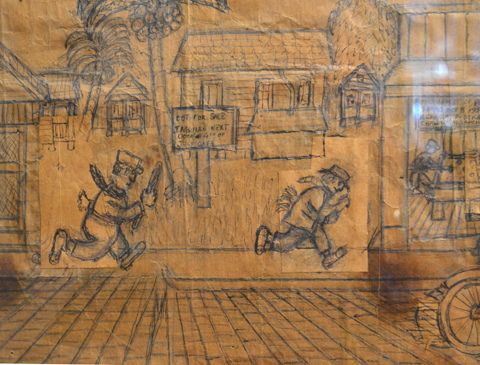
Detail of Mario Sanchez drawing at Gallery on Greene.
(PHOTO BY SCOTT PONEMONE. Courtesy of Gallery on Greene, Key West)
When I expressed interest in wanting to learn more about Mario Sanchez, I was directed to visit Nance Frank at the Gallery on Greene. Not only did Frank turn out to be THE person to learn about Sanchez, but without her I would never have met any of the other folk referred to earlier. One corner of her gallery was devoted to Sanchez. But these turned out to be reproductions. On request, Nance opened a pair of doors to invite you into a closet-size inner sanctum where the real ones hung. Street scenes like Golden Era above carried a six-figure price.
A native of Key West, Nance has represented Mario since 1994. “I don’t remember the time when I didn’t know Mario Sanchez and his work,” she said. “He was famous when I was a child. He was in a Palm Beach gallery in 1952. MoMA and the Whitney had purchased his work in the 1960s.”
She called his finished works “intaglios,” a term most commonly associated with prints pulled from metal plates. “Well, calling it carved and painted wood is kind of clumsy,” she said. “I found in an Italian dictionary that intaglio literally meant carved wood.”
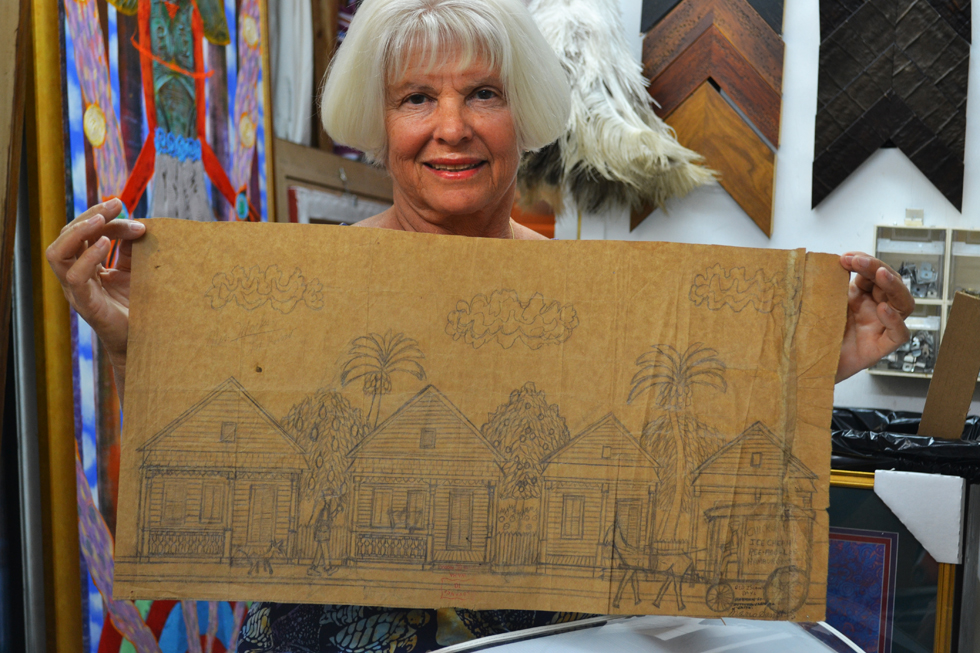
Nance Frank, director of Gallery on Greene, Key West, holds up Mario Sanchez’s drawing: Old Island Days: Bahama St. between Fleming & Eaton.
(PHOTO BY SCOTT PONEMONE. Courtesy of Gallery on Greene, Key West)
Giving Sanchez’s work a serious sounding name was only one part of Frank’s efforts to champion his career. She has published five Sanchez catalogs—four for museums and one for her gallery. She arranged a New York exhibition—Mario Sanchez, A Fisherman’s Dream—in 2012 that was threatened by Superstorm Sandy. And this year after “years of hard work” she has brought Sanchez to Cuba, where his grandparents were born.
Entitled Una Raza—One Race at Havana’s Museo Nacional de Bellas Artes until March 23, the exhibition reflects Mario’s motto: “One Race, the Human Race.” “Mario,” she said, “embraced diversity and the equality of all people and was a big believer in the American dream.” Indeed his work depicts the rich and poor; African-American, Hispanic, and Anglo; Catholic, Protestant and Jew alike—all done with a sly good humor.
When I expressed particular interest in his drawings, she referred me to David Wolkowsky, who recently bought a collection of 71 drawings and immediately loaned them to the Custom House. (Now Wolkowsky is quite a legend himself. Check out his Wikipedia listing (http://en.wikipedia.org/wiki/David_Wolkowsky) and read about his grandfather’s 1880s Key West clothing store, his own efforts at restoring inner city Philadelphia then revitalizing Key West, his private island and his philanthropy.) Then Nance phoned David and left a message that I would call him.
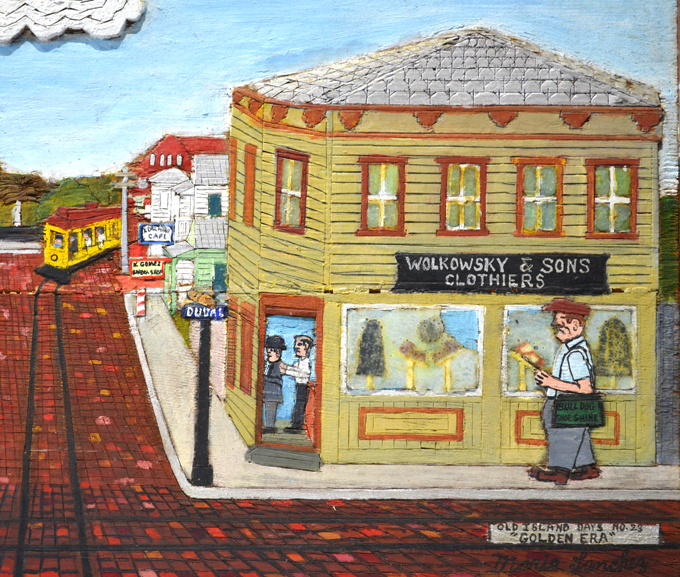
Right third of Old Island Days #23, Golden Era, showing the Wolkowsky store.
(PHOTO BY SCOTT PONEMONE. Courtesy of Gallery on Greene, Key West)
When I did call later, he answered and invited me to lunch. After I arrived, I was directed into Wolkowsky’s principal room, a pavilion-like affair held up by four huge wood columns (bought in Cambodia, he would later tell me). High above the kitchen alcove, where an African-American woman was preparing lunch, were two Assyrian-looking low reliefs. Classical statues and a huge ceramic jar added to the room’s eclectic ambiance.
David, 93, entered the room aided by a cane and sat across from me in a white leather sofa that seemed to swallow him up. The Assyrian reliefs and the statues are copies, he told me. Then he pointed out a small painting—a portrait, he says, that playwright Tennessee Williams painted of him. As to Mario Sanchez, he said, “I knew him very well. He was a very down-to-earth guy. I even commissioned him to do a drawing of my grandfather’s mens’ clothing store.”
How did he come across the collection of 71 Sanchez drawings? “I put in an ad about three years ago, asking if anyone had any Sanchezs for sale… and one person responded who had the drawings in a grocery bag.” And why loan them to the Custom House? “Because I like the museum and because the Sanchezs are part of Key West.” And when will the loan become a gift? “When I skip over the waters.” And I don’t think he was referring to his private island, Ballast Key.
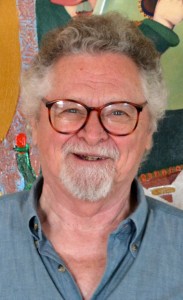
Again thanks to Nance Frank, the next person I met was Brewster Chamberlin, who is an accomplished author of travelogues, short stories, essays and poetry. He has written extensively on 20th-century European history and is currently tackling a series of novels set in Berlin. When I met him at the Custom House, he was wearing the hat of research associate of the Key West Art & Historical Society (KWAHS).
Brewster Chamberlin
(PHOTO BY SCOTT PONEMONE)
“Before I began to work on the catalogue raisonné of Sanchez’s carving and drawings,” he said, “I had become acquainted with his work in the Key West Art & Historical Society’s collection, and I’d looked into the KWAHS files containing information about works not in the collection, mainly in private collections. At some point early on I decided that a complete catalogue of these works would be of value (as complete as would be possible, that is to say, Sanchez sold or gave away many of his works for which there is no provenance information).” That was in 2002 or 2003.
“Originally my idea was to make a catalogue of the works in the KWAHS collection, and it developed from there. Eventually it may be put on the KWAHS web site, fully searchable. Whether or not it will ever be published in print, I don’t know. That’s a decision for the KWAHS leadership,” he said.
Furthermore, he said, “The catalogues will probably never be ‘complete.’ For example, when we know nothing about a carving but we know a drawing exists, I add the title and description of the drawing to the carving catalogue with the caveat that, if a drawing exists, ergo there is almost a sure possibility that a carving based on it also exists. Sanchez rarely made a drawing without basing a carving on it.”
In 2006 he coauthored a small catalogue—Mario Sanchez: Once upon A Way Of Life—with Nance Frank. So I asked him, as someone so intimate with one artist’s oeuvre, what he thought of Sanchez the artist.
“My opinion of the artist’s work has certainly changed since I first knew it a decade ago. From a mild appreciation of what I then considered a primitive, self-taught folk artist, I grew more and more to appreciate his evolving talent and knowledge of his craft,” he replied. “Additionally, I came to realize that his depictions of life in Key West and Ybor City in Tampa included the entire spectrum of the populations, their social and working lives—no group of people, ethnic, racial or working folk are missing from the carvings and drawings. Finally, I became convinced that the term ‘folk artist’ is not sufficient to describe this man and his oeuvre, and that the word ‘folk’ should be dropped from the description.”
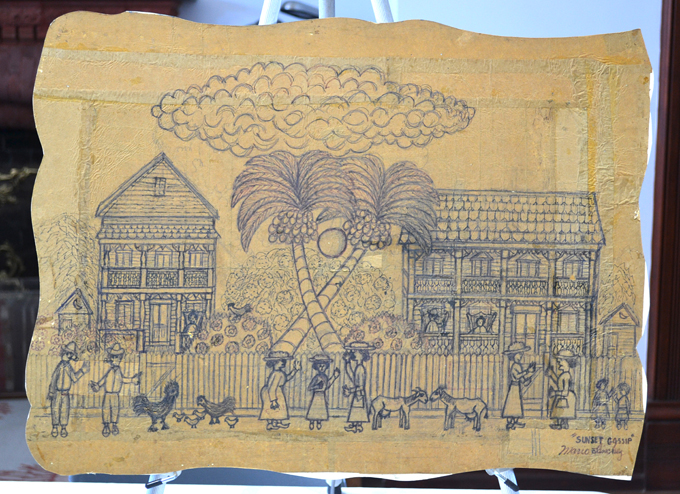
While visiting at KWAHS with Chamberlin, I met Cori Convertito, the museum’s curator. She told me that besides the Wolkowsky permanent loan the museum’s Sanchez holdings include “70 wood carvings, 1 carved frame housing a painting not done by Sanchez, 19 paper bag sketches, 4 kites.” Furthermore, she said, “Sanchez, his wife and other family members have donated works to the Society over the years as well as personal items such as his paints, tools, work bench, etc.” She said a number of Sanchez paper bag sketches on loan from Wolkowsky were included in last year’s Sanchez exhibition Grits and Grunts at the museum.
Mario Sanchez (American, 1908-2005) Sunset Gossip, paper bag & pencil, 20.25” x 27.0”, undated. Donated to KWAHS from a private collector.
(PHOTO BY SCOTT PONEMONE. Courtesy Gallery on Greene, Key West and the Key West Art & Historical Society.)
Convertito detailed Chamberlin’s cataloging efforts: “Currently, the Society is utilizing a museum collection database to catalogue and digitize the Sanchez Collection in an electronic format. The majority of the information added to the database comes directly from the Sanchez pieces themselves (title, dimensions, dates, physical condition, etc) while other information is gleaned from the catalogue raisonné compiled by Brewster and the paper files belonging to the Society. Ultimately, the database will be made accessible on our website.”
Nance Frank came through again when I asked her if I could contact Sanchez family members. She gave me the phones numbers of two of Mario’s nieces living in Tampa. So I called Marie Barnhill, and she agreed to answer questions emailed to her. These she passed on to her sister Fran Harmon. In the meantime, Marie sent me a number of family photos of her uncle.
Fran Jarmon recalled her earliest memory of Sanchez as an artist: “I am 66 years old, and I can’t remember a time when he didn’t make art. He began making stuffed fish that looked like real fish, and they were made out of newspaper and cardboard. He would mount them on a nice piece of stained wood. They looked like real fish.”
Then she went on at length describing her uncle’s working method: “As I recall, shortly after he made the stuffed fish, he carved fish on a piece of wood. He would use broken marbles, or odd buttons for eyes and he would carve them like he did the scenes that made him so famous. He would take a paper bag and glue it together. He was a simple man and he used what he had. On early bags he may have used tape or white paste, whatever he had. … He may have saved newspaper articles and used medical tape.
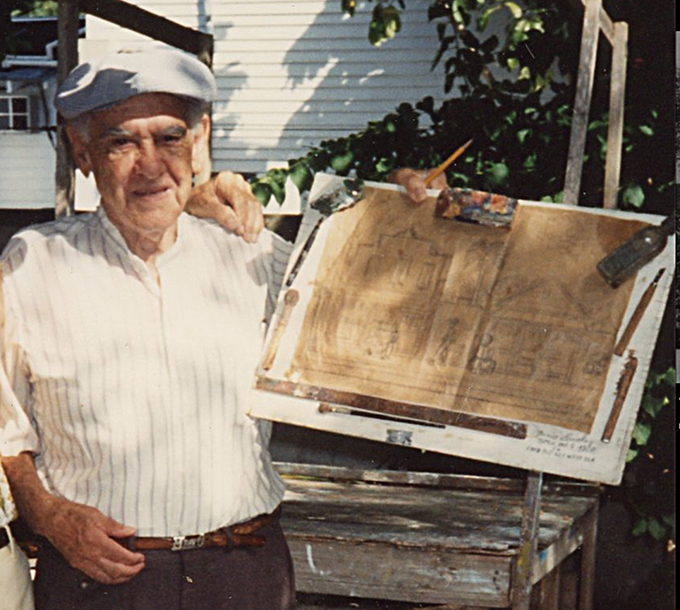
Mario Sanchez holding up Sunset Gossip drawing on grocery bag
(PHOTO COURTESY OF THE MARIO SANCHEZ FAMILY)
“Afterwards he drew the picture on the paper bag. He had a memory as sharp as could be. He knew the stories behind each character in his carvings. He would use ordinary typing carbon paper and trace the drawing onto the wood. The wood was usually two pieces of wood glued together. You couldn’t tell unless you looked at the back of the carving. Then he would use ordinary chisels. They were old and worn for the most part. I can’t remember him ever getting rid of his tools. He would sharpen them. He also used single-edge razor blades for smaller details. Last he would paint the carving. If he needed to use grass or dust or anything he had to give something more dimension, that’s what he did. Primitive wood carving fits the description.”
What did Mario think of his celebrity in later life, I asked her. “Mario never thought of himself as a celebrity,” she said. “That was so amazing about him. He was happy that his art pleased, but he never felt famous. He wore the clothes he always wore. His suits that he wore to functions in his honor were the same suits he wore for years. It didn’t matter that it wasn’t a new suit. He was comfortable and didn’t give it a second thought.”
And to her uncle’s legacy, she said: “Our uncle’s art needs to be appreciated as fine art. He was an amazing man. We grew up with my uncle. He was our mentor, and we had so much respect for him. He was way ahead of his time in his liberal ways of thinking. He would treat the mayor the same way he would treat the homeless person. He was an amazing man.”
And a final note as to why Sanchez would copy over his pencil drawings in ballpoint: I suspect he used pen when he was transferring his sketch onto a plank of wood via carbon paper.
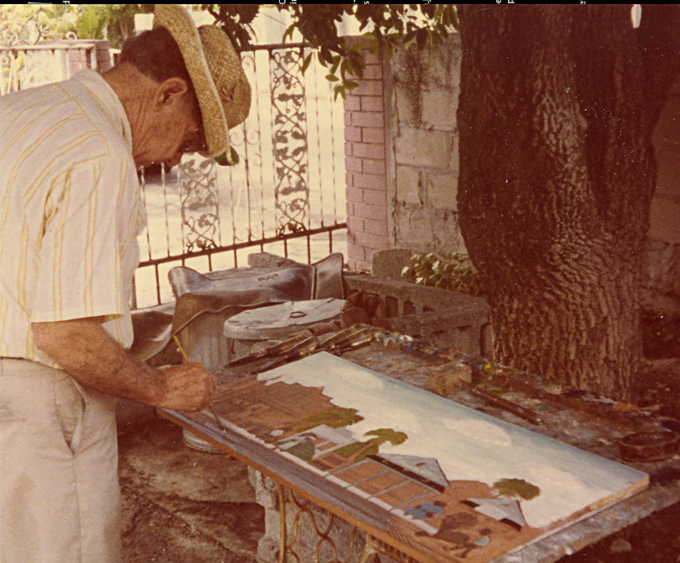
Mario Sanchez painting one of his carved panels.
(PHOTO COURTESY OF THE MARIO SANCHEZ FAMILY)
Online Links for Mario Sanchez
• Gallery on Greene: http://www.galleryongreene.com
• Key West Art & Historical Society: www.kwahs.org
• Brewster Chamberlin: http://brewsterchamberlin.com
• Web page with more Sanchez art and photos: http://www.keyshistory.org/artmariosanchez.html
Trackback URL: https://www.scottponemone.com/mario-sanchez-the-pride-of-key-west/trackback/












I have an Old Island Days that has the raised seal and is numbered in bottom right corner . I had matted and frame 15 years ago. Love it . How do I find out it’s worth?
It’s best to check with the Key West gallery that handles Sanchez artwork: http://galleryongreene.com/contact/
David passed away last week at 99.